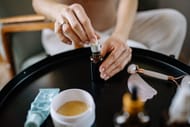Tea tree oil for skin is a potent essential oil that has been used for centuries for its medicinal properties. It is extracted from tea tree leaves, a plant native to Australia, and is known for its antiseptic, anti-inflammatory, and antimicrobial properties.
Tea tree oil has become increasingly popular in recent years for its numerous benefits for the skin.
What Does Tea Tree Oil Do for Skin?
1) Acne treatment
Tea tree oil is a popular natural remedy for acne. Its antimicrobial properties help kill the bacteria that causes acne, and its anti-inflammatory properties aid in reducing redness and inflammation. Tea tree oil can be used as a spot treatment for pimples or added to a facial cleanser or toner to prevent breakouts.
2) Reduces scarring
The anti-inflammatory properties of this oil help reduce redness and swelling, while its antiseptic properties prevent infection. Applying tea tree oil directly to the affected area can help, or you can add it to a carrier oil like coconut oil or jojoba for a more gentle application.

3) Fights fungal infections
Tea tree oil is effective against fungal infections like athlete's foot and ringwom. Its antifungal properties help kill the fungi that cause these infections. Apply tea tree oil directly to the affected area or add it to a foot soak or bath for a full body treatment.
4) Can help clear your skin
Tea tree oil for skin has many potential uses, but one of its popular use is as an acne treatment. It can help treat acne by reducing inflammation, exfoliating dead skin cells from the surface of your face, and fighting bacteria that causes pimple to appear.
If you are looking for ways to clear your skin naturally, tea tree oil may be exactly what you need!

5) Helps with rosacea and eczema symptoms
Due to its antibacterial and antiviral properties, tea tree oil helps in soothing irritated skin and redness associated with rosacea. This inflammatory skin condition causes facial flushing in response to triggers such as stress or sun exposure.
You can even use this essential oil as a spot treatment for eczema flare-ups by applying directly to affected areas two times per day until symptoms subside.

Different Types of Tea Tree Oil for Skin
There are different types of tea tree oil available for skin care. Australian tea tree oil is the most common type and is known for its potent antiseptic properties.
Meanwhile, New Zealand tea tree oil, also known as manuka oil, is derived from the Leptospermum scoparium plant and is known for its antibacterial and anti-inflammatory properties.

Cajeput tea tree oil is also effective in treating certain skin conditions and is used in aromatherapy to relieve respiratory issues.
On the other hand, Niaouli tea tree oil, derived from the Melaleuca quinquenervia tree, is known for treating acne, infections, and other skin conditions. It is commonly used in aromatherapy to help relieve respiratory issues and promote relaxation.
How to Use Tea Tree Oil for Skin
1) Spot treatment

Tea tree oil for skin can be used as a spot treatment for acne. Apply a drop of tea tree oil directly to the affected area using a cotton swab or clean fingertips. Leave it on for a few hours or overnight before rinsing off.
2) Face wash

Add a few drops of tea tree oil to your favorite face wash to help treat and prevent acne. Use this mixture to wash your face twice a day.
3) Face mask

Mix a few drops of tea tree oil with a tablespoon of honey and apply it to your face mask. Leave it on for 15-20 minutes before rising it off. This mask helps soothe skin irritations and promotes a clear complexion.
4) Moisturizer

Add a few drop of this oil to your daily moisturizer to help hydrate the skin and prevent acne.
Precautions
Tea tree oil for skin is generally safe for topical use, but it is important to dilute it properly before applying it. Undiluted tea tree oil can cause skin irritation and allergic reactions. It is important to avoid getting tea tree oil in your eyes or mouth. If you experience any skin irritation or allergic reactions, discontinue use immediately.
